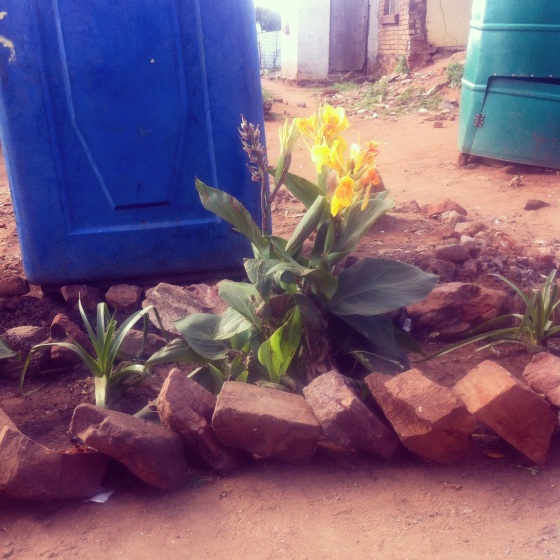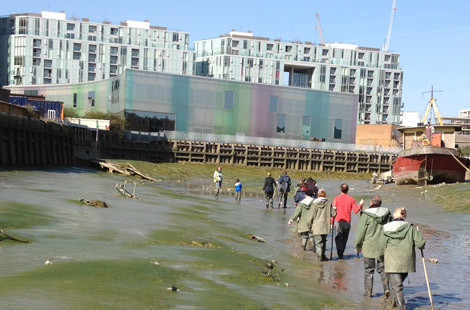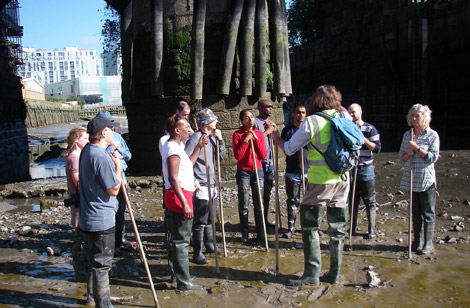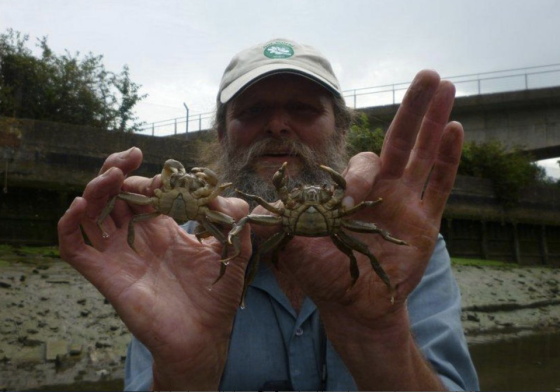I’ve been writing each month about learning about trees. This third column first appeared on Caught By The River, as will each of the monthly posts. Illustration Matt Sewell.
I am now on first name terms with a whole swathe of common and everyday trees and a number of not-so-common ones growing in my part of south east London. I’m on nodding terms with the copper beech on the road to Lewisham; with the ubiquitous rabbit-eared horse chestnut; and even the frog-footed (distinctly non-native) ginkgo that sits on the hill that takes you out of Blackheath and back down to Lee Green. I’m now at the tree-language equivalent of being able to say please, thank you and ‘two bottles of beer’.
In my notebook, I’ve been keeping a list of trees I now recognise and the list is growing. I’m pretty confident with ash, and can almost tell an oak from a distance. It’s something about the slightly diffuse shape of the leaves that makes it look hazy against the horizon, unlike a beech, whose rounded leaves cup and curve the light more softly.
This week I grasped an important technical point: tree people describe leaves as ‘pinnate’ or ‘palmate’. It took me a while but I get it now: palmate just means that the leaf is shaped like your hand, with five fat fingers radiating out from a palm, like horse chestnut, or sycamore. Pinnate describes leaves that grow with their own little stalks off a long pin-like stalk, like ash or rowan.

It really helps to understand this, because it’s a way of sorting and seeing families of tree types. Imagine for a minute you’re standing under a tree and it’s got palmate leaves that look a bit like a sycamore. It could be a sycamore or maybe a London plane, or perhaps a maple. Once you’re in the right general area (big tree, palmate leaves) you can start to find the detail. If you can see round, brown spheres hanging from the branches like woodland baubles, then it’s a plane. If it’s got seeds shaped like dolls-house coat hangers then it’s a sycamore, and if it’s got neither, and slightly smallish leaves then it’s a maple. I gave myself major bonus points when I stuffed a sycamore-ish leaf with a red stalk into my bag and worked out that it was probably a red maple. They’re all over the place in Lewisham! Who knew that the blue borough was a hotspot for Canada’s national treasure? If I’d have known earlier in the year, I’d have been up Mountsfield Park, fighting off the Staffie owners who hoist their dogs onto trees to strengthen their jaws, to do a bit of sap-tapping for my Saturday pancakes. I am told, also, that early birch leaves are good for a nibble, but that particular experiment will have to wait until next spring.
I’ve taken a scatter-fire approach to learning what the trees are called, using different resources including badgering people I know. I haven’t yet found a British tree book I really like, although I did get an excellent guide to New York’s wooded inhabitants when I was in that city last month. The trip included a feverish, flu-dosed afternoon lying on the grass in Central Park underneath a tree with paper-round seed pods which I eventually discovered was an elm. This felt like a bittersweet win: not only did I solve the puzzle of this particular tree, but it was an English tree in New York, and one that’s almost gone from our landscape, bar the 15,000 trees saved by Brighton Council during the Dutch Elm Disease epidemic of the 1970s.

My New York book has been surprisingly useful, along with my trusty, basic Woodland Trust swatch of obvious trees, and a bit of internet, despite the fact that most tree ID websites are crap. There’s also my newly-developed habit of borrowing leaves to take home. I have a growing collection of faded leaves in small piles around the house, like chlorophyll cairns.
The problem with tree books is that the specimen they photograph is just one tree on one day and it’ll look different in June than it will in January. Young trees look different from old trees. No two trees look exactly the same so it’s hard to identify a tree from one single picture. I’m sure there are good apps but I left my iPhone in Rwanda (it’s a long story) and have been using a second-hand blackberry in the interim – a phone whose crappiness is perversely attractive in a world where the internet is everywhere all the time, hence still using it a month down the line even though it drives me mad.
One tree that’s hard to miss in south London is the sycamore. In fact, so many of these have self-seeded that they’re mostly considered a weed. Consequently, I had no qualms uprooting the skinny specimen on the builders hardcore and inch of soil on the side of my ’60s maisonette, where weeds fight (and win) a battle against the random plants I’ve chucked at the ground.
I have to make a confession here: I am no stranger to arborcide. When I moved in, I cut down three massive leyandii that were growing in my tiny yard because they provided so much shade that not even ivy grew. It was my own personal Scandi forest that turned my sunny and optimistic abode into permanent gothic gloaming, and they had to go. The trees had the last laugh, though. A year after they were felled, I got a man called Andy to come round with his stump grinder. One of the tree-shards flew up like a wooden Cruise missile and struck the middle of the patio doors, transforming the pane into a spiders web of shattered glass.
Learning about trees has made me notice more than just the species. I am suddenly aware of bad pollarding, like the leylandii in front of my house – yes, another one – where my neighbour hacked the top third off, leaving a jig-jag of brutalised trunk exposed on one side. On the other hand, I find myself noticing a particularly beautiful crown, like the tree on the corner of my friend’s road. I don’t what it is, but it’s in flower now and reminds me of a pretty child’s head after she’s had curlers and ribbons put into her hair. I’m not sure I’d have even noticed it before.
I remember now that I had the same experience of clarity increasing with knowledge when I decided to learn about clouds a few years ago. I had no handle on them apart from in the broadest sense (that one looks like a dog; those ones are orange and well emotional) and then after a few months they took on their individual beauty. Look how that Lenticularis sits in the sky, just there by itself like a gorgeous, soft UFO! Or, see that pretty piece of Vellum lounging next to a bunch of puffy Cumulus! Naming allows you to engage, and to like things more. It’s probably the same with people. I remember talking to a community worker on an East London estate who’d dealt with tensions simply by introducing residents to each other. The renegade kids became people with names, and the shouty, aggressive adults became people with names and everyone got on a whole lot better.
One final thing: I just read Jay Griffiths’s book, Kith. Some of her prose is a touch too pixie for me, but she has some wonderful things to say about childhood, the woods, and the roots and routes of words. The words tree, endure, tryst, trust and truth, she says, are all related to the common Indo-European, doru or dreu.
Trees, you see. They’re at the root of everything.



















